Classroom News:
This month was super busy for our classroom. Throughout the month of February we learned all about living and nonliving things, all about nocturnal animals, fun with fairy tales, and all about sequencing with fun picture books.
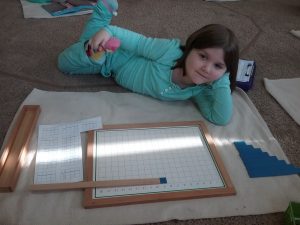
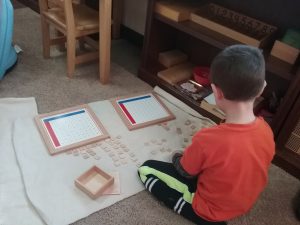
During the first week we lead a discussion about the basic needs of living things. The children did great with this. We then created a graph by using pictures that were living and nonliving and the children had to place them in right category. By doing this the children are understanding classification, and with using the pictures they can visually see the placement of the category. We then had fun the next day by bringing in hula hoops and the children had to sort objects into living or the nonliving area. By sorting, the children are understanding that certain things can be organized into certain groups so they can really get a better understanding of the concept that we are teaching. On the last day, the children were given a variety of magazines and had to cut out items that were living and nonliving. The children then had to place their pictures into the right category. I really loved this week because I feel the children really understood this concept!
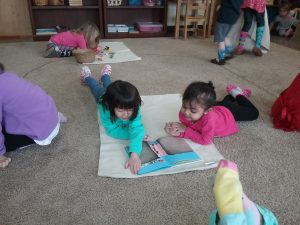
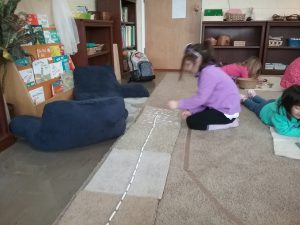
The second week was all about nocturnal animals. The first day we constricted a graph called KWL which stands for What we know, What we want to know, and What we have learned. This is a great chart because the first category the children are able to use their knowledge that they already know on the topic. The second category the children really have to brainstorm together and come up with things that they really want to learn about the topic, then on Friday we gather up all of our information that we have learned and place it on the last category. We then had a fun activity called what we do in the day and the night. The children had to draw pictures of what they do in the morning and then they had to draw what they did at night. The children each stood up one at a time and talked about what they drew. By doing this the children gain confidence in themselves and it helps them use descriptive language. We then created a Venn diagram about bats vs. owls. A Venn diagram is a visual representation of the similarities and differences between concepts. It’s a way for students to help structure the way students think about the similarities and differences between concepts.

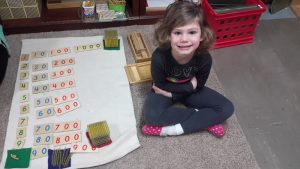
The third week we focused on fairy tales. Ms. Ame and I read a variety of fairy tales and constructed different lessons and crafts that went along with each book. We read the famous Little Red Riding Hood and made a chart that talked about what the setting was, who the characters were, the problem that was occurring in the story, how they solved it, and the lesson they thought the story was giving them. I really enjoyed doing this because it brought out new vocabulary and really made them think in a different way. Throughout the week I did this with many of the books I read. At the end of the week we went over the elements that you need to have in a fairy tale and then as a class we made up our own. It was so much fun!!
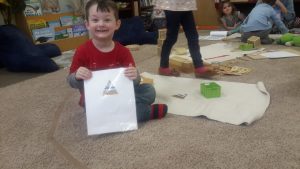
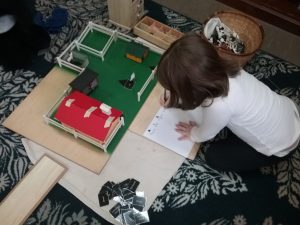
The last week we focused on sequencing. Sequencing is the process of putting events, ideas, and objects in logical order. Sequencing is important because we sequence all day. As you know we divide our time into what we need to do first, second, and last. We understand events in our lives by understanding the order in which they occur. This can be hard for young children to grasp, so this is why I choose to read many different books and have different sequencing activities for them to do to help better understand the concept.
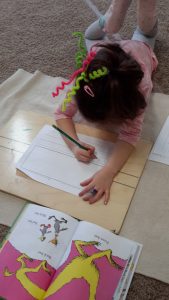
Academic Enrichment Group Time | Kindergarten
-with Mr. John
The Kindergarten students started the month by dabbling in multiplication. I explained to them that multiplication was JUST adding multiple(many) times. For example how many TIMES do we add 3 in the equation 3X4? Simple, right? Of course it is!
We then took a look at fractions. Fractions are simply dividing things into equal parts being 2, 3, 4, 5 parts and up to 12, 100, 1 million parts. Not only did we divide squares, circle, triangles into fractions but broke down how many boys/girls, who was in John’s, Kate’s, Kristen’s room, eye color, age, and who was a Buckeye fan (100% by the way).
We ended the month with a dose of geometry. We learned that a triangle has 3 sides and 3 points. A quadrilateral has 4 sides and 4 points. Learning to count to ten in Greek came in handy when dealing with polygons ie… penta is 5 and a pentagon has five sides. I threw in the right angle and what parallel means.
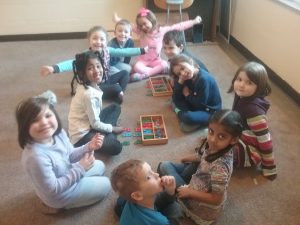
Kindergartners doing the Stamp Game (Math)
Cultural Subjects:
My line time and the kindergarten class count to ten in 28 different languages (English, Sign Language, German, French, Greek, Spanish, Italian, Romanian, Russian, Tagalog, Polish, Irish, Welsh, Hebrew, Arabic w/the Lebanese dialect, Japanese, Hungarian, Swedish, Swahili, Korean, Serbo-Croation, Hindi, Flemish/Dutch, Malay, Cebuano, Farsi and Turkish!
Handwriting Enrichment
-with Ms. Kristen
In handwriting this month, we finished up the cursive alphabet and moved on to writing vowel blends such as “th”, “sh”,”ch”, “00”, etc. The children are also answered journal questions such as ” When is your birthday?” and” If you could go on vacation, where would you go and with whom?” Something to work on and practice with your Kindergarten student this month would be spelling words phonetically. I’m so proud all the Kindergartner’s progress this month! They are becoming amazing writers!
Reading Group | Kindergarten
-with Ms. Kate
For the month of February our reading group focused on poetry. Together we read Knoxville, Tennessee, Picture Books In Winter, and April Rain Song. Each one of these poems were about a different season that the author truly loves. With each of these readings, the children were able to draw their favorite season and explain to their friends the reason they picked that season. They also had fun creating a drawings of their favorite book and what they like most about the rain. During our time together we go over different vocabulary that they see in their readings and discuss what those terms mean. Together as a class the children created a poem about summer in their city. I hope you enjoy this fantastic poem they created together.
Cuyahoga Falls, Ohio
I always like summer best
You can eat corn on the cob
Hot dogs on the grill
Sweet watermelon
And Ice cream
You can go to
The beach
To the pool
Baseball games
To the park
And take vacations
You can see
Butterflies
Green leaves on the tree
Birds
People playing outside
Lightning bugs at night.
Science Enrichment
-by Ms. Kathleen
This past month all 3 Science experiments were about Buoyancy; a force in a liquid pushing against an object in a liquid.
Floating and Sinking Oranges: Mr. John peeled one orange and left the other peeled(boy did the room smell good!) the children placed in a tank of water. When dropped in the water, the orange with the peel on floated and the orange without the peel sank. This is because of air trapped by the peel making the orange float. The peeled orange has no air so it sinks.
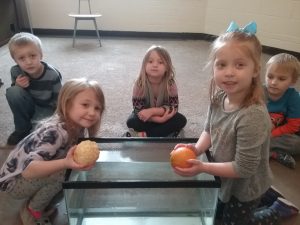
Using oranges to explain buoyancy
Play Dough Shapes A Bowl and a Sphere: The children dropped 1 piece of play dough shaped as a sphere in water and one shaped like bowl in water. The sphere shaped dough sank while the bowl shaped dough floated. This is because sphere shaped dough is dense and cannot push enough water out to stay floating. The dough shaped like a bowl is able to push out water equal it’s weight and therefore, floats.
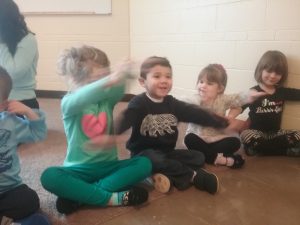
Students pushing away water to explain buoyancy
Soda Float with 2 cans of Coke (regular vs. diet): We placed both cans of soda in the water. The diet floated and the regular sank. This is because regular soda contains sugar and diet contains artificial sweeteners. These artificial sweeteners may be 100 times sweeter than sugar, which means that less than a few grams of artificial sweeteners are used in a can of diet soda. The difference in the amount of grams of sweeteners leads to a different density.
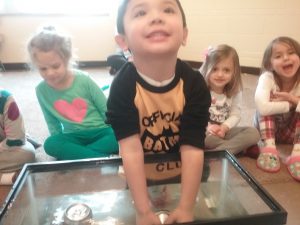
Using two cans of “POP” to explain buoyancy
Art Enrichment
-by Ms. Ame
February has flown by so fast! We started the month with painting our personally created clay creatures from January. The students used a variety of colors and spent almost the whole hour carefully decorating them. Once they dried on the drying rack, the students were able to take them home!
If you haven’t grabbed your child’s little creature, please do and take them home! Then Miss Michele began our next unit, weaving! She has started the students off with paper weaving. The students learned the pattern of over-under-over-under of weaving with large strips of paper. They will continue with weaving projects as we head into March. Keep checking the art carts to take home your students creations both from art and line time lessons! We are constantly creating all sorts of art projects each week!
Music Enrichment
-by Ms. Sabrina
A synthesizer was talked about. It is a piano that can sound like a trumpet as well as other instruments. It was used to play the game Cat and Mouse. It is a game to hone listening skills. Listening for the highest to lowest sounds. The children had so much fun. A song about being diligent was played. The children were taught to try and try and try again. A train whistle was used, so was a triangle as well as maracas. A dancing they went.
A new song about telling the truth was sung. Sign Language was used and so were foot movements. The children also learned about echo’s via music. The musical instrument used was the maraca. What fun the children had making echos. Performing with scarves were thoroughly enjoyed as well. Let the Sun Shine In was the song they danced to.

